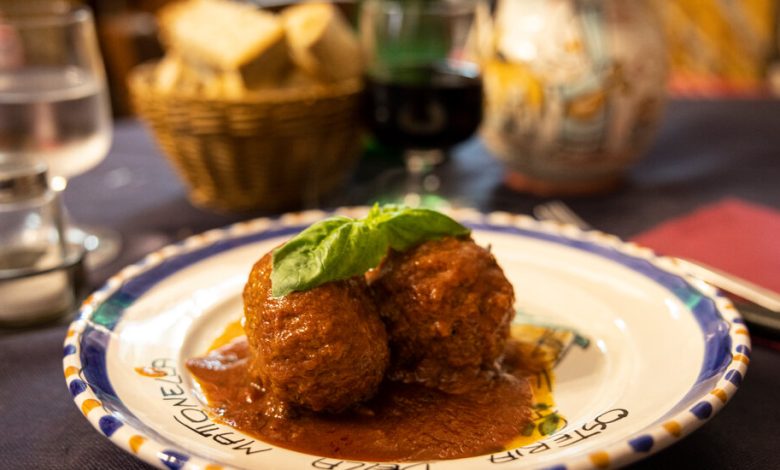5 Restaurants in Naples Where You Can Forget About Pizza

The worldwide culinary fame of Italy’s third-largest city boils down to one word: pizza. You can hardly hurl a tomato in the food’s purported birthplace — a scruffy, graffiti-stained port city of monumental Baroque buildings and narrow cobbled passageways — without hitting a gaggle of culinary pilgrims jockeying to enter one of the hundreds (or thousands, by some counts) of pizzerias.
But a slew of top-notch trattorias, osterias and ristoranti exist right alongside pizza titans like Sorbillo and Da Michele. Drawing on the cornucopia of livestock and produce from the fertile fields and coastal waters of the Campania region — cattle, goats, shellfish, wheat, artichokes, zucchini, figs, citrus fruits and more — these eateries dish out local inventions from mussel soup to homegrown pastas to limoncello.
So when you’re ready to foray beyond the overcrowded dens of dough and red sauce, here are five addresses in five neighborhoods offering both traditional and creative takes on beloved Neapolitan recipes and ingredients. Buon appetito.
Osteria della Mattonella
History suffuses this homey, family-run restaurant tucked into the tight grid of streets that forms the working-class Quartieri Spagnoli district, a hillside zone where laundry seems to hang from every rusted wrought-iron balcony.
As opera arias and sentimental Italian ballads echo off the swirly, hand-painted, 18th-century wall tiles, a succession of time-honored Neapolitan dishes passes from the open kitchen to the worn wooden tables, where a mainly Italian clientele gobbles them down: fried eggplant, fried zucchini, fried rice balls, myriad meatballs and ziti under generous ladles of thick, tomato-beef Neapolitan ragù (also on sale in jars for 8.50 euros, or about $9.25).
The seafood offerings are equally worthy, including tender anchovies and cod drenched in a dense sauce of tomatoes, capers and olives. For a coda, you can balance salty with sweet thanks to a sticky baba au rhum — a favorite Franco-Polish dessert adopted in Napoli in the 18th century.
Osteria della Mattonella, Via Giovanni Nicotera 13. A three-course meal costs around 25 euros per person.
Tripperia O’Russ
Centuries ago, women from Napoli’s lower classes would gather outside royal residences in hopes of being granted the discarded entrails of the animals slaughtered for aristocrats’ banquets.
These days you need only go to one of the city’s tripe restaurants to taste this enduring favorite, traditionally referred to as cucina povera — the food of the poor — which is made variously from pigs’ feet, veal snout and bovine stomachs.
Begun as a pushcart business in 1945, Tripperia O’Russ has for decades occupied a simple, brightly lit white dining room on a middle-class residential street near the city’s botanical gardens, earning a reputation as Naples’s top temple of tripe. Amid the sound of hacking, a mix of local folks from all walks of life gather to dine on simple soups, pastas and stews loaded with slow-cooked innards.
The Tris Trippa sampler, ideal for the uninitiated, is a trio of tripe preparations: with potatoes and a thin sauce of olive oil, onions, peppers and tomato; with heavy tomato sauce; and with a mix of tomato sauce and beans. Those with more daring palates can enjoy carpaccio-ish slices of cooked veal tripe with just a lemon wedge as accompaniment. The restaurant serves no desserts, but big bottles of Peroni beer (2.50 euros) complement the onslaught.
Tripperia O’Russ, Via San Eframo Vecchio 68. A tripe medley and beer cost 12.50 euros.
La Locanda Gesù Vecchio
Despite its rustic décor and location in Naples’s historic center, this cozy and popular spot is no relic. Loaded with craft beers (including a mild, easy-drinking house I.P.A.) and a secondary menu of gluten-free options, the four-year-old restaurant is run by a young, tattooed staff and serves a clientele of in-the-know international foodies.
Nonetheless, the reverent, old-school menu would have your Neapolitan grandmother smiling with recognition at items like eggplant parmigiana and pasta with potatoes and provolone cheese.
Among the antipasti, the mozzarella in carrozza demonstrates that the classic Campania cheese can be melted into tasty variations that require no pizza oven. Heated to stretchiness and spread on thick slices of egg-dipped grilled bread, the mozzarella becomes the star of a bubbly, gooey sandwich. The cheese makes another cameo in the crispy fried paccheri — a beloved Neapolitan noodle stuffed with a combination of tomato sauce, beef, pork, pork lard, raisins, pine nuts and mozzarella.
If you can (and it will be a challenge), save room for the meaty, tomato sauce-drenched chunks of rabbit cacciatore — a favorite dish from the nearby island of Ischia.
La Locanda Gesù Vecchio, Via Giovanni Paladino 26. A three-course meal costs around 30 euros per person.
Seafront Pasta Bar
Plenty of onions and lots of time. Those are the secrets to Genovese sauce, a Naples specialty despite its Genoa-derived name. Concocted mainly from finely sliced onions — slow-cooked over a low flame for several hours — along with olive oil and tender slivers of beef, the sauce is so emblematic of Naples that it probably deserves a towering monument in the grand square that the restaurant overlooks, Piazza Municipio.
The chunky, chewy ziti with Genovese sauce is just one of the flavorful noodle creations at Seafront Pasta Bar, a minimalist Scandinavian-chic dining room above the boutique for the Di Martino pasta manufacturer, which also operates the restaurant. Like the ziti, the dry noodles sold in the shop and served upstairs are made at the company’s factory in the nearby town of Gragnano, a pasta mecca in Italy thanks to its long history of pasta-making and the many top brands still based there.
Rich local flavors also come together in the spaghetti alle vongole — a swirl of buttery noodles larded with tender, sweet clams and charred garlic that arrive under a glass dome of olive-oil smoke — and bucatini with an Ischia-inspired tomato sauce containing tender shredded rabbit.
Noodles even contribute to certain desserts, notably “pastamisù,” a classic tiramisù topped with coffee-soaked pasta shards that have been baked to crispiness.
Sea Front Pasta Bar, Piazza Municipio 1. For two pastas and dessert, expect to pay around 60 to 70 euros.
Sustanza
To find the new Sustanza restaurant, cross the street from the national archaeological museum; enter the soaring, glass-covered arcades of the 19th-century Galleria Principe di Napoli; slip past the potted palms and white-coated bartenders that fill the Art Nouveau-style Scotto Jonno cocktail bar; and climb the carpeted stone steps until you reach elegant dining rooms decorated with swirling Liberty-esque wallpaper and real Tiffany lamps.
Opened in May, this hidden-away restaurant serves intricate dishes of southern Italian and Mediterranean ingredients accompanied by natural wines. The menu comes courtesy of the chef Marco Ambrosino, a native of the nearby island of Procida who previously made a name for himself at 28 Posti in Milan.
On a recent evening, his concoctions featured several imaginative deployments of classic Campania ingredients, notably an artichoke heart filled with mountain truffle cream, and succulent mutton in a light sauce of jus and fermented butter. Dessert might be an herbaceous fig-leaf sorbet in laurel oil.
For a nightcap, consider returning to the ground-floor lounge. The Strega del Vesuvio cocktail (15 euros), as red and potent as the volcano it is named for, blends Scotch, gin, coffee liqueur and a cordial of tomatoes grown on Vesuvio’s slopes into a tangy, smoky digestivo.
Sustanza, Galleria Principe di Napoli. The five-course tasting menu is 80 euros.
Follow New York Times Travel on Instagram and sign up for our weekly Travel Dispatch newsletter to get expert tips on traveling smarter and inspiration for your next vacation. Dreaming up a future getaway or just armchair traveling? Check out our 52 Places to Go in 2023.




